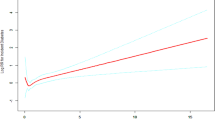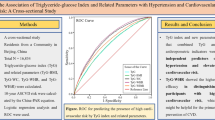Abstract
The aim of this study was to clarify the relationship between fasting and nonfasting serum triglyceride (TG) levels and the incidence of hypertension in a general Japanese population. We conducted a population-based retrospective cohort study using annual health check-up data of residents of Iki City, Nagasaki Prefecture, Japan. A total of 3202 participants without hypertension at baseline were included in the present analysis. TG levels were classified as quartile 1 (<0.82 mmol/L), quartile 2 (0.83–1.13 mmol/L), quartile 3 (1.14–1.70 mmol/L) and quartile 4 (≥1.71 mmol/L) for men, and as quartile 1 (<0.70 mmol/L), quartile 2 (0.71–0.96 mmol/L), quartile 3 (0.97–1.34 mmol/L) and quartile 4 (≥1.35 mmol/L) for women. The outcome was incident hypertension. During an average follow-up of 4.4 years, 983 participants developed hypertension, according to the Cox proportional hazards model. The annual incidence of hypertension increased with an elevation in TG levels for men (5.88% in quartile 1, 8.30% in quartile 2, 7.62% in quartile 3, and 9.82% in quartile 4). This association was significant, even after adjustment for other risk factors: hazard ratio 1.41 [95% CI 1.07–1.85] for quartile 2, 1.30 [0.99–1.71] for quartile 3, and 1.59 [1.22–2.08] for quartile 4 compared with quartile 1 (p = 0.041 for trend). In contrast, there was no clear association between serum TG levels and the incidence of hypertension after adjustment for confounding factors among women (p = 0.240 for trend). High levels of serum TG were associated with the future incidence of hypertension in a general population of Japanese men but were not associated with that in women.

Casual serum triglyceride levels and incidence of hypertension in a general Japanese population: ISSA-CKD study
This is a preview of subscription content, access via your institution
Access options
Subscribe to this journal
Receive 12 print issues and online access
$259.00 per year
only $21.58 per issue
Buy this article
- Purchase on Springer Link
- Instant access to full article PDF
Prices may be subject to local taxes which are calculated during checkout
Similar content being viewed by others
References
James SL, Abate D, Abate KH, Abay SM, Abbafati C, Abbasi N, et al. Global, regional, and national incidence, prevalence, and years lived with disability for 354 diseases and injuries for 195 countries and territories, 1990–2017: a systematic analysis for the Global Burden of Disease Study 2017. Lancet. 2018;392:1789–858.
Umemura S, Arima H, Arima S, Asayama K, Dohi Y, Hirooka Y, et al. The Japanese Society of Hypertension guidelines for the management of hypertension (JSH 2019). Hypertens Res. 2019;42:1235–481.
Kinoshita M, Yokote K, Arai H, Iida M, Ishigaki Y, Ishibashi S, et al. Japan Atherosclerosis Society (JAS) guidelines for prevention of atherosclerotic cardiovascular diseases 2017. J Atheroscler Thromb. 2018;2:864–984.
Hisamatsu T, Segawa H, Kadota A, Ohkubo T, ArimaH, Miura K. Epidemiology of hypertension in Japan: beyond the new 2019 Japanese guidelines. Hypertens Res. 2020;43:1344–51.
Satoh A, Arima H, Ohkubo T, Nishi N, Okuda N, Ae R, et al. Associations of socioeconomic status with prevalence, awareness, treatment, and control of hypertension in a general Japanese population: NIPPON DATA2010. J Hypertens. 2017;35:401–8.
Fujiyoshi A, Ohkubo T, Miura K, Murakami Y, Nagasawa S-Y, Okamura T, et al. Blood pressure categories and long-term risk of cardiovascular disease according to age group in Japanese men and women. Hypertens Res. 2012;35:947–53.
Keech A, Simes RJ, Barter P, Best J, Scott R, Taskinen MR, et al. Effects of long-term fenofibrate therapy on cardiovascular events in 9795 people with type 2 diabetes mellitus (the FIELD study): randomised controlled trial. Lancet 2005;366:1849–61.
Koh KK, Ahn JY, Quon MJ, Kim J, Han SH, Lee Y, et al. Additive beneficial effects of fenofibrate combined with candesartan in the treatment of hypertriglyceridemic hypertensive patients. Diabetes Care. 2006;29:195–201.
Kim J, Tsujino T, Fujioka Y, Saito K, Yokoyama M. Bezafibrate improves hypertension and insulin sensitivity in humans. Hypertens Res. 2003;26:307–13.
Ishikawa T, Obara T, Kataoka H, Hanazawa T, Tanaka K, Shibamiya T, et al. Bloodpressure lowering effect of fenofibrate evaluated by home blood pressure. Ther Res. 2007;28:1853–62.
Hunt SC, Stephenson SH, Hopkins PN, Williams RR. Predictors of an increased risk of future hypertension in Utah. Hypertension 1991;17:969–76.
Hoffner SM, Miettinen H, Gaskill SP, Stern MP. Metabolic precursors of hypertension. Arch Intern Med. 1996;156:1994–2000.
Paynter NP, Sesso HD, Conen D, Otvos JD, Mora S. Lipoprotein subclass abnormalities and incident hypertension in initially healthy women. Clin Chem. 2011;57:1178–87.
Laaksonen DE, Niskanen L, Nyyssonen K, Lakka TA, Laukkanen JA, Salonen JT. Dyslipidemia as a predictor of hypertension in middle-aged men. Eur Heart J. 2008;29:2561–8.
Tohidi M, Hatami M, Hadaegh F, Azizi F. Triglycerides and triglycerides to high-density lipoprotein cholesterol ratio are strong predictors of incident hypertension in Middle Eastern women. J Hum Hypertens. 2012;26:525–32.
Sanchez-Inigo L, Navarro-Gonzalez D, Pastrana-Delgado J, Fernandez- Montero A, Alfredo Martinez J. Association of triglycerides and new lipid markers with the incidence of hypertension in a Spanish cohort. J Hypertens. 2016;34:1257–65.
Ding C, Yang Z, Wang S, Sun F, Zhan S. The association of metabolic syndrome with incident hypertension, type 2 diabetes mellitus and chronic kidney disease: a cohort study. Endocrine 2018;60:282–91.
Tomita Y, Sakata S, Arima H, Yamato I, Ibaraki A, Ohtsubo T, et al. Relationship between casual serum triglyceride levels and the development of hypertension in Japanese. J Hypertens. 2021;39:667–82.
Northeastward BG, Langsted A, Mora S, Kolovou G, Baum H, Bruckert E, et al. Fasting is not routinely required for determination of a lipid profile: clinical and laboratory implications including flagging at desirable concentration cut-points-a joint consensus statement from the European Atherosclerosis Society and European Federation of Clinical Chemistry and Laboratory Medicine. Eur Heart J. 2016;37:1944–58.
Yasuno T, Maeda T, Tada K, Takahashi K, Ito K, Abe Y, et al. Effects of HbA1c on the development and progression of chironic kidney disease in elderly and middle-aged Japanese: Iki Epidemiological Study of Atherosclerosis and Chronic Kidney Disease (ISSA-CKD). Intern Med. 2020;59:175–80.
Ito K, Maeda T, Tada K, Takahashi K, Yasuno T, Masutani K, et al. The role of cigarette smoking on new-onset of chronic kidney disease in a Japanese population without prior chronic kidney disease: Iki Epidemiological Study of Atherosclerosis and Chronic Kidney Disease (ISSA-CKD). Clin Exp Nephrol. 2020;24:919–26.
Miyabayashi I, Mori S, Satoh A, Kawazoe M, Funakoshi S, Ishida S, et al. Uric acid and prevalence of hypertension in a general population of Japanese: ISSA-CKD Study. J Clin Med Res. 2020;12:431–5.
Ishida S, Kondo S, Funakoshi S, Satoh A, Maeda T, Kawazoe M, et al. White blood cell count and incidence of hypertension in the general Japanese population: ISSA-CKD study. PLoS ONE. 2021;16:e0246304.
Fujii H, Funakoshi S, Maeda T, Satoh A, Kawazoe M, Ishida S, et al. Eating speed and incidence of diabetes in Japanese general population: ISSA-CKD. J Clin Med. 2021;10:1949 https://doi.org/10.3390/jcm10091949.
Tada K, Maeda T, Takahashi K, Ito K, Yasuno T, Funakoshi S, et al. Association between serum uric acid and new onset and progression of chronic kidney disease in a Japanese general population: Iki Epidemiological Study of Atherosclerosis and Chronic Kidney Disease. Clin Exp Nephrol. 2021;25:751–9.
Abe M, Fujii H, Funakoshi S, Satoh A, Kawazoe M, Maeda T, et al. Comparison of body mass index and waist circumference in the prediction of diabetes: a retrospective longitudinal study. Diabetes Ther. 2021;12:2663–76.
Okutsu S, Kato Y, Funakoshi S, Maeda T, Yoshimura C, Kawazoe M, et al.> Effects of weight gain after 20 years of age and incidence of hyper-low-density lipoprotein cholesterolemia: The Iki Epidemiological Study of Atherosclerosis and Chronic Kidney Disease (ISSA-CKD. J Clin Med. 2021;10:3098 https://doi.org/10.3390/jcm10143098.
Funakoshi S, Satoh A, Maeda T, Kawazoe M, Ishida S, Yoshimura C, et al. Eating before bed and new-onset hypertension in a Japanese population: The Iki City Epidemiological Study of Atherosclerosis and Chronic Kidney Disease. Hypertens Res. 2021;44:1662–7.
The Japanese Society of Cardiovascular Disease Prevention. Handbook for cardiovascular prevention. Hokendojinsha, Japan; 2014.
Zoungas S, Arima H, Gerstein HC, Holman RR, Woodward M, Reaven P, et al. Effects of intensive glucose control on microvascular outcomes in patients with type 2 diabetes: a meta-analysis of individual participant data from randomised controlled trials. Lancet Diabetes Endocrinol. 2017;5:431–7.
Alberti KG, Eckel RH, Grundy SM, Zimmet PZ, Cleeman JI, Donato KA, et al. Harmonizing the metabolic syndrome: a joint interim statement of the International Diabetes Federation Task Force on Epidemiology and Prevention; National Heart, Lung, and Blood Institute; American Heart Association; World Heart Federation; International Atherosclerosis Society; and International Association for the Study of Obesity. Circulation 2009;120:1640–5.
Arima H, Kiyohara Y, Kato I, Tanizaki Y, Kubo M, Iwamoto H, et al. Alcohol reduces insulin-hypertension relationship in a general population: The Hisayama study. J Clin Epidemiol. 2002;55:863–9.
Vekic J, Zeijkovic A, Cicero AFG, Janez A, Stoian, Rizzo M. Atherosclerosis development and progression: the role of atherogenic small, dense LDL. Medicina. 2022;58:299 https://doi.org/10.3390/medicina58020299.
Kume N, Kita T. Apoptosis of vascular cells by oxidized LDL: Involvement of caspases and LOX 1 and its implication in a therosclerotic plaque rupture. Circ Res 2004;94:269–70.
Mancia G, Bombelli M, Corrao G, Facchetti R, Madotto F, Giannattasio C, et al. Metabolic syndrome in the Pressioni Arteriose Monitorate E Loro Associazioni (PAMELA) Study. Daily life blood pressure, cardiac damage, and prognosis. Hypertension. 2007;49:40–7.
Funding
This study was supported by research grants from Iki City. HA received funding from a commercial source, Daiichi Sankyo and Kyowa Kirin. This does not alter our adherence to Hypertension Research policies on sharing data and materials.
Author information
Authors and Affiliations
Corresponding author
Ethics declarations
Conflict of interest
The authors declare no competing interests.
Additional information
Publisher’s note Springer Nature remains neutral with regard to jurisdictional claims in published maps and institutional affiliations.
Supplementary information
Rights and permissions
Springer Nature or its licensor (e.g. a society or other partner) holds exclusive rights to this article under a publishing agreement with the author(s) or other rightsholder(s); author self-archiving of the accepted manuscript version of this article is solely governed by the terms of such publishing agreement and applicable law.
About this article
Cite this article
Ishida, S., Kondo, S., Funakoshi, S. et al. Serum triglyceride levels and incidence of hypertension in a general Japanese population: ISSA-CKD study. Hypertens Res 46, 1122–1131 (2023). https://doi.org/10.1038/s41440-023-01175-4
Received:
Revised:
Accepted:
Published:
Issue Date:
DOI: https://doi.org/10.1038/s41440-023-01175-4
Keywords
This article is cited by
-
Preface–Metabolic aspects of hypertension in Asia
Hypertension Research (2023)



